The anticipation is over, the fall run of striped bass is well underway and every coastal angler worth his salt is excited. The fall run is the southward migration of this highly prized gamefish, part of the double migration lifestyle that makes it so unique. Striped bass are anadromous, a term that refers to a fish that spends most of their lives in saltwater but spawn in freshwater. Salmon are also anadromous, but unlike Pacific salmon that only spawn once and die, striped bass can live up to 30-years and spawn annually from the time they reach sexual maturity between five and seven years of age.
Females grow much larger than males, which rarely get larger than 25 pounds. The larger the female, the more eggs it carries. A 50-pound female can produce over 4 million eggs per spawn and will mate with numerous males gathered alongside her to fertilize those eggs while beating the water around her with their tails to aid fertilization. The two major spawning stocks are centered around the rivers of the Chesapeake Bay and Hudson River, with far less significant spawning taking place in rivers as far north as Canada.
The spawning run is just one of two annual migrations of mature striped bass. The second begins after males and females of the two major stocks leave the spawning rivers to begin a migration to their summer feeding grounds in the waters off New England. There they feed heavily until the water begins to cool signaling the beginning of the much-heralded fall run. This is when bass head back south, feeding at every opportunity along the way until they get to their wintering grounds off the MidAtlantic states. Some winter over in the Hudson and Chesapeake estuaries. The timing is spread out over several months with bass often traveling in groups according to size.
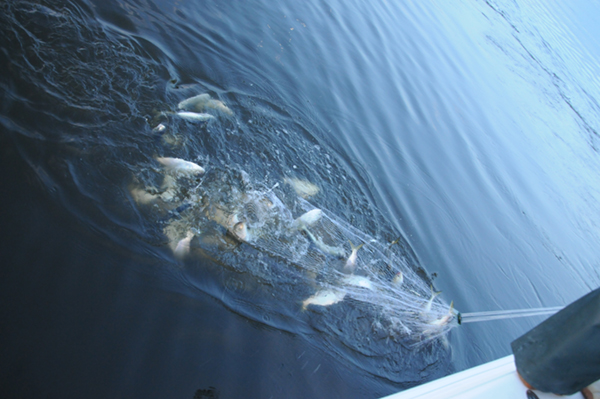
The Bait Parade
Stripers aren’t the only fish migrating in fall. A dozen species of forage fish begin moving out of estuaries and tidal rivers as waters cool and head for the ocean. The northern mullet run begins in September. As estuary waters continue to cool, young menhaden called peanuts, in addition to a variety of other smaller baitfish like silversides and bay anchovies, leave estuary waters and begin moving south usually very close to the beach. Mature menhaden are on the move and can be found frequently in massive schools of hundreds of thousands of fish well into November and even December. As some species move south, sand eels and herring move inshore from the offshore waters they frequent during the warmer months to add to the striped bass’ forage base. Bait movements are temperature driven and can vary from year to year with a lot of overlap. Putting it all together for a successful day of fishing is akin to putting together a fishy jigsaw puzzle that makes for interesting choices in the tackle and techniques.
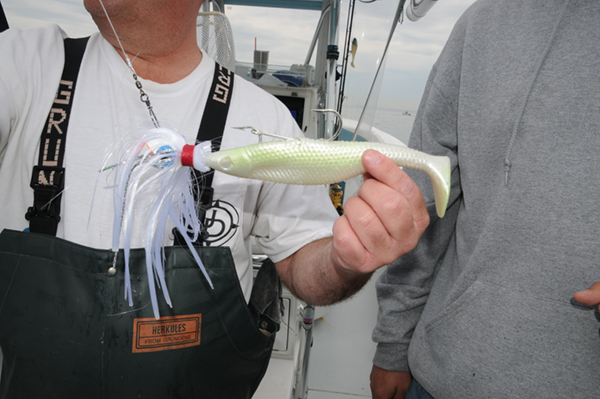
The Eyes Have It
The challenge on any given day is to find a concentration of bass and figure out what they are feeding on, then match your tactics accordingly. To make things even more interesting, various year classes of bass can be found in close proximity on any given day. You might have big fish inshore feeding on menhaden at the same time schools of younger mature fish will be on smaller baitfish nearby. One day, you might find only 10-to-20-pound bass, mostly males, the next you might luck into pods of big females.
Working birds can frequently point you in the right direction, especially when gannets are bunched up and hitting the water marking where bass have pushed a school of large baitfish to the surface. Pay close attention to what is going on around you. Watch for feeding bass breaking on the surface and schools of bunker being driven by hungry stripers. Even a few gannets can give away an area where baitfish are concentrated. A good pair of binoculars and a radar unit that can pick up working birds from great distances will extend your surface vision. That said, you will find the most bass with your eyes beneath the surface, your fishfinder. It will help you locate bait concentrations and show you if there are bass mixed in with them. It can also provide a decent idea of their size and the depth they are holding. If you have side scan sonar, you can cover even more area and identify targets further away from the boat. All this information makes picking a specific technique easier.
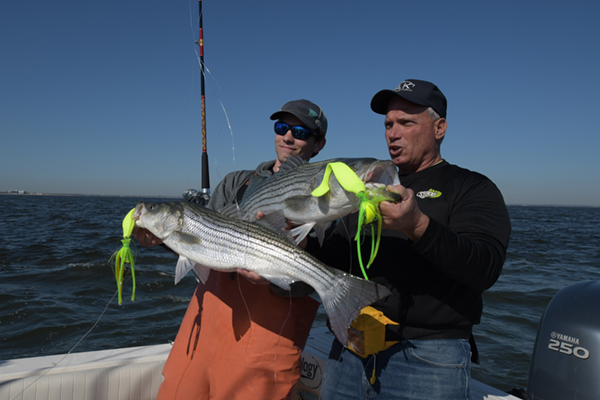
No Bait Techniques
No bait techniques include trolling, jigging and casting artificial lures. Two favorite trolling techniques that work for anglers of almost any experience level are wireline and bunker spoons or braided line with mojos. Both techniques offer the bonus of presenting your lures at various levels of the water column. Just because there is a lot of forage in an area doesn’t mean the bass are feeding 24/7.
When stripers are not actively feeding, they typically travel closer to the bottom. At these times bunker spoons and mojos can initiate a strike when pulled through their field of vision. Both lures put out pulsing vibrations, the spoon as it swings from side to side and the mojo as the tail of the large plastic shad moves enticingly as it swims. The vibrations can be detected by the sensors in the striper’s lateral line and lead them to your lures. The other benefit of these two lures is they can both be trolled shallow or deep depending on how heavy the lure is and how fast it is being pulled. Spoons can attain depths of 40-feet and mojos even deeper if necessary. Both spoons and mojos catch best in two colors, plain white and plain chartreuse. So if you’re on a budget, stick with the most productive colors because these lures are not cheap. Both techniques have been around for decades and are as effective today as they were 50 or more years ago.
When bass are busting baitfish on the surface or hanging around large schools of menhaden between feeding periods, you can coax strikes on swimming plugs, poppers and shad lures. Always have a couple of spinning outfits that can handle large and medium size lures at the ready even when trolling because when the fish start smacking on top, you can bring in the trolling gear and get in on the light tackle fun. Lures to have include metal lip swimming plugs (either wood or plastic), pencil poppers, Musky Doc or similar cigar shaped surface plugs that work erratically on the surface when jerked, and the great standby, large plastic shad lures. Most of these lures imitate bunker of various sizes.
A more recent entrant to the striper arsenal is the flutter spoon. These oversize metal lures run up to nine inches in length and can be worked on a conventional outfit or stout spinning tackle. Flutter spoons are worked vertically when bass are under the boat by dropping them to the depth of the fish and lifting them with the rod tip, then letting them flutter back down on a slack line watching the line between the rod tip and the water to detect a strike. Most hits come when the spoon is falling. You can also work these big metals on the drift still doing the lift and drop, but out away from the boat letting out more line as needed.
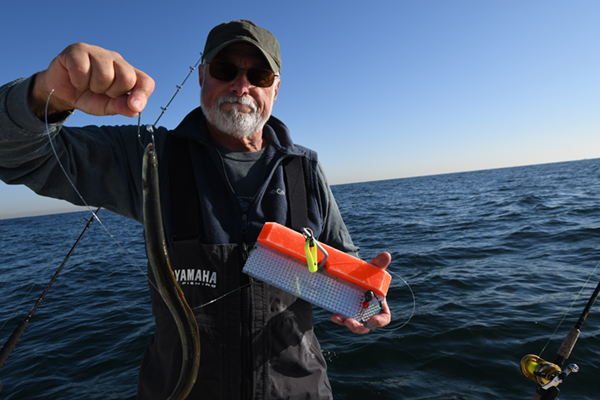
A Yamaha Exclusive for Trolling
All trolling techniques, including the live eels with planers and floats, are made easier when your boat is equipped with Yamaha’s exclusive Helm Master EX® system. One or two people can tend multiple trolling outfits, keep the boat moving at the exact speed necessary for specific trolling techniques including automatically bump-trolling at speeds down to one mile per hour with the “Pattern Shift” feature. You can also let the boat steer itself by using the integrated autopilot. The technology makes it possible for the boat driver to stay in the action while the boat almost drives itself.
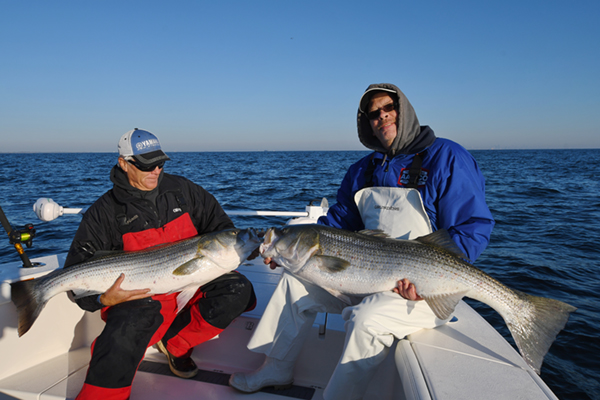
Live Bait Techniques
The two live baits standouts during the fall run are menhaden and eels. Depending on where you fish you might also be able to obtain live spot. To fish live menhaden you have to catch them using bunker snags, large weighted treble hooks used to snag them or a cast net. Bunker cast nets should be ten feet with large mesh netting and heavily weighted around the circumference, so they sink quickly. Throwing a big cast net takes practice as does approaching a school of menhaden on which to throw the net. But, there are plenty of videos online that will guide you through the learning process. You will also have to have an efficient livewell on your boat to keep them frisky. Live eels can be caught in eel pots, but are also readily available from some shore area bait and tackle stores.
Recent changes to the coastwide regulations imposed on striped bass include a provision that you must use non-offset circle hooks when using any kind of live or dead bait - and there’s a trick to using them for stripers, especially large stripers.
Far too many anglers use circle hooks that are too small and miss a lot of runoffs as a result. The reason is simple. Stripers have a very large jaw structure and mouths, and a circle hook works by wrapping itself around the jaw. A circle hook that is too small can’t easily wrap around the jaw, so use 9/0 light wire circles for eels and 10/0 for menhaden. Menhaden can be hooked in the nostrils, through the lower and upper jaw, in the back or, a favorite location on the underside a few inches forward of the tail. Do not, however, hook the belly so you don’t puncture any internal organs.
That hook location makes it easier to get the bait to swim away from you by just putting a little pressure on the line after you drop it alongside the boat or cast it. When bass are present but you’re not getting bites, try casting a live bunker in a high arch above the water, so it makes a big splash. It’s almost a guarantee that bass will rush to the surface to investigate the commotion. You can swim live menhaden in and around bait schools, cast them to structure like jetties and inlet groins, or put a weight on a 3-way swivel and drop them down close to the bottom if you find fish that are not actively feeding and holding deep.
Live eels are deadly cast on a spinning outfit, pulled along from a drifting boat over structure or bump-trolled at very slow speeds using side planers and floats. The “planer and float” technique is a proven killer for targeting big bass, even in deep water where you would think they would not come to the surface to strike them.
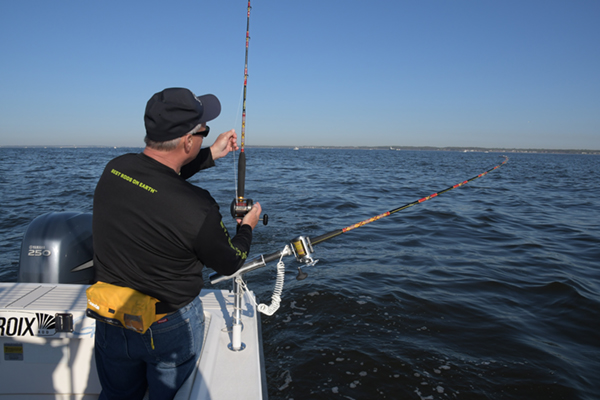
Now you know what to expect, the basics of finding fall run striped bass, and the techniques that work to catch them. All you have to do is get out there with the thousands of other anglers from New York to Virginia who are looking forward to the fall madness that is often the best saltwater fishing of the year. Back to Blue Life
Females grow much larger than males, which rarely get larger than 25 pounds. The larger the female, the more eggs it carries. A 50-pound female can produce over 4 million eggs per spawn and will mate with numerous males gathered alongside her to fertilize those eggs while beating the water around her with their tails to aid fertilization. The two major spawning stocks are centered around the rivers of the Chesapeake Bay and Hudson River, with far less significant spawning taking place in rivers as far north as Canada.
The spawning run is just one of two annual migrations of mature striped bass. The second begins after males and females of the two major stocks leave the spawning rivers to begin a migration to their summer feeding grounds in the waters off New England. There they feed heavily until the water begins to cool signaling the beginning of the much-heralded fall run. This is when bass head back south, feeding at every opportunity along the way until they get to their wintering grounds off the MidAtlantic states. Some winter over in the Hudson and Chesapeake estuaries. The timing is spread out over several months with bass often traveling in groups according to size.

The Bait Parade
Stripers aren’t the only fish migrating in fall. A dozen species of forage fish begin moving out of estuaries and tidal rivers as waters cool and head for the ocean. The northern mullet run begins in September. As estuary waters continue to cool, young menhaden called peanuts, in addition to a variety of other smaller baitfish like silversides and bay anchovies, leave estuary waters and begin moving south usually very close to the beach. Mature menhaden are on the move and can be found frequently in massive schools of hundreds of thousands of fish well into November and even December. As some species move south, sand eels and herring move inshore from the offshore waters they frequent during the warmer months to add to the striped bass’ forage base. Bait movements are temperature driven and can vary from year to year with a lot of overlap. Putting it all together for a successful day of fishing is akin to putting together a fishy jigsaw puzzle that makes for interesting choices in the tackle and techniques.

The Eyes Have It
The challenge on any given day is to find a concentration of bass and figure out what they are feeding on, then match your tactics accordingly. To make things even more interesting, various year classes of bass can be found in close proximity on any given day. You might have big fish inshore feeding on menhaden at the same time schools of younger mature fish will be on smaller baitfish nearby. One day, you might find only 10-to-20-pound bass, mostly males, the next you might luck into pods of big females.
Working birds can frequently point you in the right direction, especially when gannets are bunched up and hitting the water marking where bass have pushed a school of large baitfish to the surface. Pay close attention to what is going on around you. Watch for feeding bass breaking on the surface and schools of bunker being driven by hungry stripers. Even a few gannets can give away an area where baitfish are concentrated. A good pair of binoculars and a radar unit that can pick up working birds from great distances will extend your surface vision. That said, you will find the most bass with your eyes beneath the surface, your fishfinder. It will help you locate bait concentrations and show you if there are bass mixed in with them. It can also provide a decent idea of their size and the depth they are holding. If you have side scan sonar, you can cover even more area and identify targets further away from the boat. All this information makes picking a specific technique easier.

No Bait Techniques
No bait techniques include trolling, jigging and casting artificial lures. Two favorite trolling techniques that work for anglers of almost any experience level are wireline and bunker spoons or braided line with mojos. Both techniques offer the bonus of presenting your lures at various levels of the water column. Just because there is a lot of forage in an area doesn’t mean the bass are feeding 24/7.
When stripers are not actively feeding, they typically travel closer to the bottom. At these times bunker spoons and mojos can initiate a strike when pulled through their field of vision. Both lures put out pulsing vibrations, the spoon as it swings from side to side and the mojo as the tail of the large plastic shad moves enticingly as it swims. The vibrations can be detected by the sensors in the striper’s lateral line and lead them to your lures. The other benefit of these two lures is they can both be trolled shallow or deep depending on how heavy the lure is and how fast it is being pulled. Spoons can attain depths of 40-feet and mojos even deeper if necessary. Both spoons and mojos catch best in two colors, plain white and plain chartreuse. So if you’re on a budget, stick with the most productive colors because these lures are not cheap. Both techniques have been around for decades and are as effective today as they were 50 or more years ago.
When bass are busting baitfish on the surface or hanging around large schools of menhaden between feeding periods, you can coax strikes on swimming plugs, poppers and shad lures. Always have a couple of spinning outfits that can handle large and medium size lures at the ready even when trolling because when the fish start smacking on top, you can bring in the trolling gear and get in on the light tackle fun. Lures to have include metal lip swimming plugs (either wood or plastic), pencil poppers, Musky Doc or similar cigar shaped surface plugs that work erratically on the surface when jerked, and the great standby, large plastic shad lures. Most of these lures imitate bunker of various sizes.
A more recent entrant to the striper arsenal is the flutter spoon. These oversize metal lures run up to nine inches in length and can be worked on a conventional outfit or stout spinning tackle. Flutter spoons are worked vertically when bass are under the boat by dropping them to the depth of the fish and lifting them with the rod tip, then letting them flutter back down on a slack line watching the line between the rod tip and the water to detect a strike. Most hits come when the spoon is falling. You can also work these big metals on the drift still doing the lift and drop, but out away from the boat letting out more line as needed.

A Yamaha Exclusive for Trolling
All trolling techniques, including the live eels with planers and floats, are made easier when your boat is equipped with Yamaha’s exclusive Helm Master EX® system. One or two people can tend multiple trolling outfits, keep the boat moving at the exact speed necessary for specific trolling techniques including automatically bump-trolling at speeds down to one mile per hour with the “Pattern Shift” feature. You can also let the boat steer itself by using the integrated autopilot. The technology makes it possible for the boat driver to stay in the action while the boat almost drives itself.

Live Bait Techniques
The two live baits standouts during the fall run are menhaden and eels. Depending on where you fish you might also be able to obtain live spot. To fish live menhaden you have to catch them using bunker snags, large weighted treble hooks used to snag them or a cast net. Bunker cast nets should be ten feet with large mesh netting and heavily weighted around the circumference, so they sink quickly. Throwing a big cast net takes practice as does approaching a school of menhaden on which to throw the net. But, there are plenty of videos online that will guide you through the learning process. You will also have to have an efficient livewell on your boat to keep them frisky. Live eels can be caught in eel pots, but are also readily available from some shore area bait and tackle stores.
Recent changes to the coastwide regulations imposed on striped bass include a provision that you must use non-offset circle hooks when using any kind of live or dead bait - and there’s a trick to using them for stripers, especially large stripers.
Far too many anglers use circle hooks that are too small and miss a lot of runoffs as a result. The reason is simple. Stripers have a very large jaw structure and mouths, and a circle hook works by wrapping itself around the jaw. A circle hook that is too small can’t easily wrap around the jaw, so use 9/0 light wire circles for eels and 10/0 for menhaden. Menhaden can be hooked in the nostrils, through the lower and upper jaw, in the back or, a favorite location on the underside a few inches forward of the tail. Do not, however, hook the belly so you don’t puncture any internal organs.
That hook location makes it easier to get the bait to swim away from you by just putting a little pressure on the line after you drop it alongside the boat or cast it. When bass are present but you’re not getting bites, try casting a live bunker in a high arch above the water, so it makes a big splash. It’s almost a guarantee that bass will rush to the surface to investigate the commotion. You can swim live menhaden in and around bait schools, cast them to structure like jetties and inlet groins, or put a weight on a 3-way swivel and drop them down close to the bottom if you find fish that are not actively feeding and holding deep.
Live eels are deadly cast on a spinning outfit, pulled along from a drifting boat over structure or bump-trolled at very slow speeds using side planers and floats. The “planer and float” technique is a proven killer for targeting big bass, even in deep water where you would think they would not come to the surface to strike them.

Now you know what to expect, the basics of finding fall run striped bass, and the techniques that work to catch them. All you have to do is get out there with the thousands of other anglers from New York to Virginia who are looking forward to the fall madness that is often the best saltwater fishing of the year. Back to Blue Life
